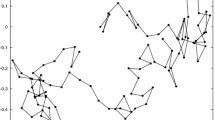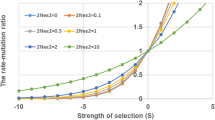Abstract
The evolution of genetic systems has been analyzed through the use of modifier gene models, in which a neutral gene is posited to control the transmission of other genes under selection. Analysis of modifier gene models has found the manifestations of an “evolutionary reduction principle”: in a population near equilibrium, a new modifier allele that scales equally all transition probabilities between different genotypes under selection can invade if and only if it reduces the transition probabilities. Analytical results on the reduction principle have always required some set of constraints for tractability: limitations to one or two selected loci, two alleles per locus, specific selection regimes or weak selection, specific genetic processes being modified, extreme or infinitesimal effects of the modifier allele, or tight linkage between modifier and selected loci. Here, I prove the reduction principle in the absence of any of these constraints, confirming a twenty-year-old conjecture. The proof is obtained by a wider application of Karlin’s Theorem 5.2 (Karlin in Evolutionary biology, vol. 14, pp. 61–204, Plenum, New York, 1982) and its extension to ML-matrices, substochastic matrices, and reducible matrices.
Similar content being viewed by others
References
Altenberg, L., 1984. A generalization of theory on the evolution of modifier genes. Ph.D. thesis, Stanford University. Searchable online and available from University Microfilms, Ann Arbor, MI.
Altenberg, L., Feldman, M.W., 1987. Selection, generalized transmission, and the evolution of modifier genes. I. The reduction principle. Genetics 117, 559–572.
Balkau, B., Feldman, M.W., 1973. Selection for migration modification. Genetics 74, 171–174.
Barton, N.H., 1995. A general model for the evolution of recombination. Genet. Res. (Camb.) 65, 123–144.
Cavalli-Sforza, L.L., Feldman, M.W., 1973. Models for cultural inheritance. I. Group mean and within group variation. Theor. Popul. Biol. 4, 42–55.
Charlesworth, B., 1976. Recombination modification in a fluctuating environment. Genetics 83, 181–195.
Charlesworth, B., 1993. Directional selection and the evolution of sex and recombination. Genet. Res. (Camb.) 61, 205–224.
Cohen, J.E., 1978. Derivatives of the spectral radius as a function of non-negative matrix elements. Math. Proc. Camb. Philos. Soc. 83, 183–190.
Cohen, J.E., 1979. Random evolutions and the spectral radius of a non-negative matrix. Math. Proc. Camb. Philos. Soc. 86, 345–350.
Cohen, J.E., 1981. Convexity of the dominant eigenvalue of an essentially nonnegative matrix. Proc. Am. Math. Soc. 81, 657–658.
Deutsch, E., Neumann, M., 1984. Derivatives of the Perron root at an essentially nonnegative matrix and the group inverse of an M-matrix. J. Math. Anal. Appl. 102, 1–29.
Deutsch, E., Neumann, M., 1985. On the first and second order derivatives of the Perron vector. Linear Algebra Appl. 71, 57–76.
Feldman, M.W., 1972. Selection for linkage modification: I. Random mating populations. Theor. Popul. Biol. 3, 324–346.
Feldman, M.W., Balkau, B., 1973. Selection for linkage modification: II. A recombination balance for neutral modifiers. Genetics 74, 713–726.
Feldman, M.W., Krakauer, J., 1976. Genetic modification and modifier polymorphisms. In: Karlin, S., Nevo, E. (Eds.), Population Genetics and Ecology, pp. 547–583. Academic Press, New York.
Feldman, M.W., Liberman, U., 1986. An evolutionary reduction principle for genetic modifiers. Proc. Natl. Acad. Sci. USA 83, 4824–4827.
Feldman, M.W., Otto, S.P., 1991. A comparative approach to the population genetic theory of segregation distortion. Am. Nat. 137, 443–456.
Feldman, M.W., Christiansen, F.B., Brooks, L.D., 1980. Evolution of recombination in a constant environment. Proc. Natl. Acad. Sci. USA 77, 4838–4841.
Feldman, M.W., Otto, S.P., Christiansen, F.B., 1997. Population genetic perspectives on the evolution of recombination. Annu. Rev. Genet. 20, 261–295.
Felsenstein, J., 1974. The evolutionary advantage of recombination. Genetics 78, 737–756.
Felsenstein, J., Yokoyama, S., 1976. The evolutionary advantage of recombination. II. Individual selection for recombination. Genetics 83, 845–859.
Fisher, R.A., 1922. On the dominance ratio. Proc. R. Soc. Edinb. 42, 321–341.
Fisher, R.A., 1930. The Genetical Theory of Natural Selection. Clarendon Press, Oxford.
Friedland, S., 1981. Convex spectral functions. Linear Multilinear Algebra 9, 299–316.
Friedland, S., Karlin, S., 1975. Some inequalities for the spectral radius of non-negative matrices and applications. Duke Math. J. 42, 459–490.
Gantmacher, F.R., 1959. The Theory of Matrices, vol. 2. Chelsea, New York.
Haldane, J.B.S., 1924. A mathematical theory of natural and artificial selection. Part I. Trans. Camb. Philos. Soc. 23, 19–41.
Hamilton, W.D., 1980. Sex versus non-sex versus parasite. Oikos 35, 282–290.
Karlin, S., 1982. Classification of selection-migration structures and conditions for a protected polymorphism. In: Hecht, M.K., Wallace, B., Prance, G.T. (Eds.), Evolutionary Biology, vol. 14, pp. 61–204. Plenum, New York.
Karlin, S., McGregor, J., 1972. The evolutionary development of modifier genes. Proc. Natl. Acad. Sci. USA 69, 3611–3614.
Karlin, S., McGregor, J., 1974. Towards a theory of the evolution of modifier genes. Theor. Popul. Biol. 5, 59–103.
Kimura, M., 1956. A model of a genetic system which leads to closer linkage by natural selection. Evolution 10, 278–287.
Liberman, U., Feldman, M.W., 1986a. Modifiers of mutation rate: A general reduction principle. Theor. Popul. Biol. 30, 125–142.
Liberman, U., Feldman, M.W., 1986b. A general reduction principle for genetic modifiers of recombination. Theor. Popul. Biol. 30, 341–371.
Liberman, U., Feldman, M.W., 1989. The reduction principle for genetic modifiers of the migration rate. In: Feldman, M.W. (Ed.), Mathematical Evolutionary Theory, pp. 111–137. Princeton University Press, Princeton.
Maynard Smith, J., 1988. Selection for recombination in a polygenic model—the mechanism. Genet. Res. (Camb.) 51, 59–63.
Nei, M., 1967. Modification of linkage intensity by natural selection. Genetics 57, 625–641.
Odling-Smee, J., 2007. Niche inheritance: A possible basis for classifying multiple inheritance systems in evolution. Biol. Theory 2, 276–289.
Schauber, E., Goodwin, B., Jones, C., Ostfeld, R., 2007. Spatial selection and inheritance: applying evolutionary concepts to population dynamics in heterogeneous space. Ecology 88, 1112–1118.
Seneta, E., 1981. Non-negative Matrices and Markov Chains. Springer, New York.
Wright, S., 1931. Evolution in Mendelian populations. Genetics 16, 97–159.
Zhivotovsky, L.A., Feldman, M.W., Christiansen, F.B., 1994. Evolution of recombination among multiple selected loci: A generalized reduction principle. Proc. Natl. Acad. Sci. USA 91, 1079–1083.
Author information
Authors and Affiliations
Corresponding author
Additional information
Dedicated to my doctoral advisor Marc Feldman on his 65th birthday, and to the memory of Marc’s doctoral advisor, Sam Karlin, who each laid the foundations necessary for these results; and to my mother Elizabeth Lee and to the memory of my father Roger Altenberg, who together laid the foundation necessary for me.
Rights and permissions
About this article
Cite this article
Altenberg, L. The Evolutionary Reduction Principle for Linear Variation in Genetic Transmission. Bull. Math. Biol. 71, 1264–1284 (2009). https://doi.org/10.1007/s11538-009-9401-2
Received:
Accepted:
Published:
Issue Date:
DOI: https://doi.org/10.1007/s11538-009-9401-2




